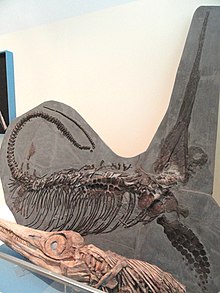Excalibosaurus
| Excalibosaurus | |
|---|---|

| |
| Fossil, Royal Ontario Museum | |
| Scientific classification | |
| Kingdom: | Animalia |
| Phylum: | Chordata |
| Class: | |
| Order: | †
Ichthyosauria |
| Family: | |
| Genus: | Excalibosaurus McGowan, 1986
|
| Binomial name | |
| Excalibosaurus costini McGowan, 1986
| |
Excalibosaurus (meaning "
History of research

This relatively rare animal is known from two skeletons. The
Description
The holotype specimen has a skull length of 78.5 cm (2 ft 6.9 in), while the largest specimen has a skull length of 1.54 m (5 ft 1 in).[3] The larger specimen has a total length of 6.528 metres (21.42 ft).[4]
Classification
Excalibosaurus is related to two other genera of ichthyosaurs, Leptonectes from the Rhaetian (Late Triassic) to the Sinemurian (Early Jurassic) of England and Eurhinosaurus from the Toarcian (Early Jurassic) of Germany. The three genera are grouped in the family Leptonectidae.[5][6][3] It was once thought that Excalibosaurus was a junior synonym of Eurhinosaurus,[7] but the description of the 1996 specimen show many morphological differences such as the shape of the forefin (much shorter and broader in Excalibosaurus), the slender shape of the body, that clearly differentiate the two genera.[3]
See also
- List of ichthyosaurs
- Timeline of ichthyosaur research
References
- ^ "Excalibosaurus at Fossilworks". Paleobiology Database. Fossilworks. Retrieved 17 December 2021.
- S2CID 4255439.
- ^ S2CID 129236415.
- .
- .
- ^ Michael W. Maisch & Andreas T. Matzke (2000). "The Ichthyosauria". Stuttgarter Beiträge zur Naturkunde. Serie B. 298: 1–159.
